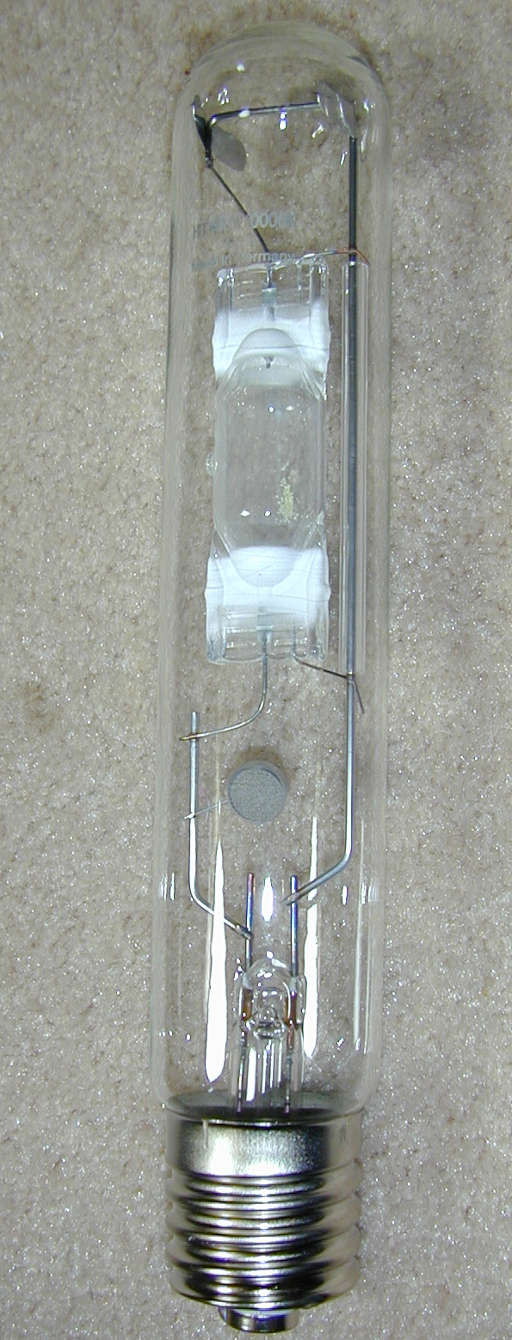
Ushio 400w 10,000k Bulb
This is the Ushio 400w 10k bulb that I have used (images of 175w version is below). This bulb is manufactured by a the Japanese company Ushio located in Germany. I used Iwasaki lamps for many years. When I upgraded my lighting system to 400w ballast I decided to try the 10,000k bulb. I was surprised to find that this bulb is not much whiter than Iwasaki bulbs. I was expecting more of a white/black difference than a slight shade of white difference. I was really expecting to see more of a bluish color to the bulb. One thing to keep in mind is that I'm using a standard PFO 400w ballast on this lamp. I'm told the bulb will burn brighter and whiter with a 400w HQI ballast. The Ushio 10,000k lamp has a higher color temp than most daylight bulb but to my eye this should still be considered a full daylight bulb. The number "10,000K" is one way of rating colors for bulbs (there seem to be many). The short version is that a theoretical entity called a "black body" will produce a color of light based on the temperature the "black body" is heated to (as measured on the Kelvin Scale). A black body is an object which reflects no light - any light seen from the object is produced by the object. It gets worse, I'll spare the details. In any case, things can only be measured in this fashion if they have the properties similar to a black body. Light bulbs do not truly act as a black body so these ratings are guesses at best. For example, its possible to have greenish, yellow, or bluish 10,000K bulbs. They are all rated the same, but to the eye they have different colors. |

Ushio 175w 10,000k Bulb
(The 175w version displayed below was used on the holding tanks for my livestock while the tank was being moved and reef room and reef viewing room was being constructed.) In general however, the higher the color temperature the more to the blue end of the spectrum a bulbs color tends to be. 6500K bulbs in general need actinic supplementation to make the tank look nice to the eye or it will have a yellowish/greenish color. Some of the bluer 10,000K bulbs, and most 20,000K bulbs do not need actinics light because they are so blue in color. Now to make things confusing: Just because a bluish bulb looks blue, does not mean it creates more blue wavelength light than a say a yellow bulb. In fact, the 6500K bulbs actually create more blue light then a 20,000K bulb--but yet seem yellowish/greenish. Why is that? The reason is that overall the 6500K bulb produces more light in all spectrums: more blue, more green, more yellow. The color temperature of bulbs can reasonably be used to simulate different depths on the reefs. 6500K bulbs being full spectrum can be used to simulate the shallow waters of the reef crest. 10,000K bulbs could be used for the mid range of 15 meters depth perhaps. And 20,000K bulbs can be used for real deep simulation of say 30 meters or more. |

Metal Halide Nipple Orientation
Metal Halide bulbs have an internal nipple which usually must always face upward. If you fail to do this the bulb may not light, or it could flicker. This seems to be very important when using electronic ballast to power your metal halide lights. (Actually, the nipple itself does nothing, its just a reference. However, the glass bulb has an internal vessel that has a slope. This slope is upward from left to right if the base of the bulb was on your left side.) |
